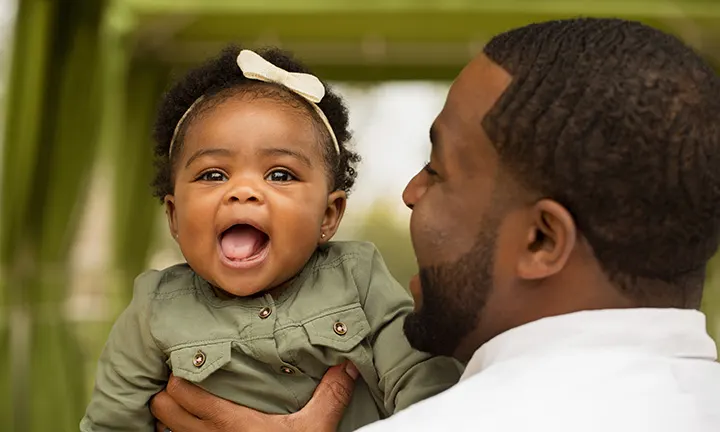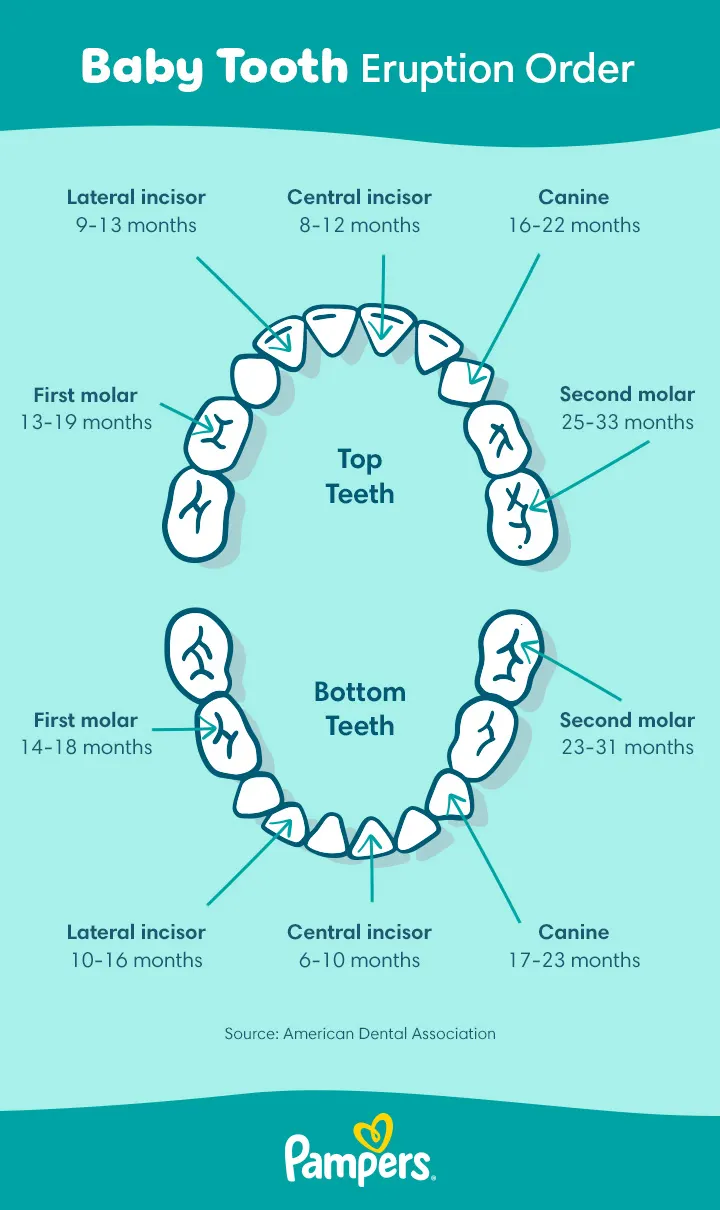Your Baby’s Teething Chart and Timeline
Your baby’s first tooth is an exciting milestone, one of many you'll observe in the early months. Read on to find out when teething typically starts, which baby teeth tend to come in first, and when (and in which order) the rest of your little one’s baby teeth are likely to appear. Our baby teeth chart will give you a clearer idea of which tooth is which!
When do Babies Start Teething?
Generally, teething can begin anywhere between the age of 3 and 12 months. However, in some very rare cases a baby may even be born with a tooth already erupted.
Just as each child is an individual, teething timelines will vary from child to child – there’s no strict schedule. Your baby’s first tooth is likely to appear sometime around 6 months, although in some cases it could even take as long as 12 to 14 months for this to happen.
Look out for signs of teething, such as tender gums, constant drooling or gnawing on a fist or finger.
How Many Baby Teeth Will Appear in Total?
Your baby’s first teeth are known as primary or milk teeth, and by around the age of 3 years, they will probably have a full set of 20 teeth. When your child is around 5 or 6 years old, these milk teeth will eventually start falling out to make way for permanent adult teeth.
Baby Teeth Chart
This baby and toddler teeth chart can show you when each of your little one’s first set of teeth is likely to come in and when they may fall out.
Although the exact age when teething starts and the eruption of the various baby teeth will vary from child to child, the baby teeth chart below is a rough guide to when babies typically get their teeth and the order they usually come in.
A Typical Baby Teething Timeline
Growing teeth is not a competitive sport, and your baby’s teeth will arrive when they’re ready. The timeline below is just a general guide (as with the teething chart above), and children vary a lot in age when it comes to their teething schedule, so don’t be concerned if your friends’ babies get teeth earlier or later than your baby does.
Below shows an approximate age range and eruption order for each tooth as an alternative to the baby and toddler teeth chart.
Baby Teething Timeline
5-10 months. You'll likely spot that first tooth popping through when your baby is about 6 months old, although they can come in as late as 12 to 14 months. Keep in mind, teething symptoms sometimes begin as early as 3 months, and don’t be surprised if the first tooth makes an earlier appearance. Usually, it’ll be the lower front teeth (known as the central incisors) that come through first.
8-12 months. The next to erupt are usually the top front teeth. These teeth are also called central incisors.
9-16 months. The next set of teeth due to pop up are the lateral incisors, which are on either side of the front teeth. The top ones usually appear first, followed by the lower lateral incisors (the teeth on either side of the bottom middle ones).
13-19 months. Sometime after your baby turns around 1 year of age, it might be time in
their teething timeline for their first molars (your baby’s back teeth) to arrive, most likely starting with those top molars.
16-23 months. At around this age, the first canines (the sharp, pointy teeth on either side of the incisors) make an appearance.
21-33 months. Sometime between your child’s second and third birthday, those second molars could arrive to finally fill in any last gaps, and your little one will now have a full set of 20 primary teeth.
Is Teething Painful for Babies or Toddlers?
For some babies, teething is painless, but for others, it may occasionally cause mild irritability and crying. Much of the discomfort comes from the gums around the new teeth as they erupt, which can become swollen and tender.
If you’re concerned about your baby showing discomfort because of teething, there are plenty of things you can do to soothe teething symptoms. For example, give your little one a chilled teething ring to chew on or crunchy finger foods like breadsticks if your child is already eating solids.
You could also ask your little one’s GP, health visitor or dentist for additional advice if you’re concerned about the discomfort your baby is in due to teething.
Reducing the Risk of Choking
Remember that babies may attempt to chew even before they get their teeth but may not always fully chew their food before swallowing. This is why it’s always important to be mindful of choking risks and supervise your little one when they’re eating.
Even when children have a full set of teeth, but certainly before, certain foods present a choking hazard. Grapes and cherry tomatoes, for example, should always be quartered (long ways) before being served to babies or toddlers.
Learn more about starting your baby on solid foods as they start to sprout teeth.
Dental Care
It’s important to start taking care of your baby’s teeth as soon as the first one pokes through. Those teeth still have to last a good few years yet before they’re replaced with adult teeth and establishing good dental hygiene habits early will help set your little one up for lifelong healthy dental care habits.
Use a tiny smear of baby toothpaste on a brush designed for your little one’s age. Brushing a baby’s first teeth can be tricky, but don’t worry if you don’t make a perfect job of it – the important thing at this stage is to get your little one used to the idea of regular brushing.
Read more about looking after your baby’s teeth and going for regular dental check-ups.
When Do Baby Teeth Fall Out?
Children usually lose their first primary teeth around 6 years of age. The table below offers an approximate age range for when each tooth typically falls out. Keep in mind, this table shows an average range, and it may happen a little differently for your child.
| Top teeth | When the tooth falls out |
|---|---|
| Central incisor | 6 to 7 years |
| Lateral incisor | 7 to 8 years |
| First molar | 9 to 11 years |
| Canine | 10 to 12 years |
| Second molar | 10 to 12 years |
| Bottom teeth | When the tooth falls out |
|---|---|
| Central incisor | 6 to 7 years |
| Lateral incisor | 7 to 8 years |
| First molar | 9 to 11 years |
| Canine | 9 to 12 years |
| Second molar | 10 to 12 years |
FAQS AT A GLANCE
Baby teeth usually appear in the following order:
- Central incisors
- Lateral incisors
- First molars
- Canines
- Second molars.
The Bottom Line
If you’re still looking forward to seeing that first toothy grin, don’t worry – some babies start cutting their teeth earlier and some later than others. If your baby is already teething, be patient: It can sometimes seem that just as the discomfort of one tooth breaking through is over, the next one starts to erupt.
Using our baby teething chart and timeline can help give you a clearer idea of what a typical teething timeline looks like, making the whole process a little more predictable and reassure you that your baby’s teething woes won’t last forever. Take care of your baby’s new teeth and before you know it the gaps in your little one’s smile will be filled in with some of the cutest, whitest baby teeth you’ve ever seen!
How We Wrote This Article The information in this article is based on the expert advice found in trusted medical and government sources, such as the National Health Service (NHS). You can find a full list of sources used for this article below. The content on this page should not replace professional medical advice. Always consult medical professionals for full diagnosis and treatment.
Join Pampers Club and get:




